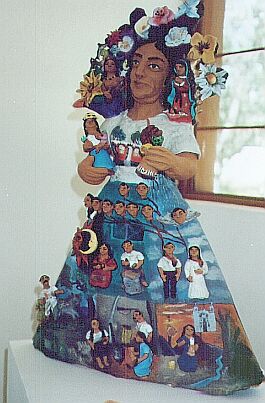Home >>
Oaxaca >>
An Expatriate Life >>
Letters >> Traffic Control...

This is the work of Demitrio Aguilar, descendent of the famous Aguilar family of ceramicists. The road in front of the Aguilar compound outside of Ocotlan de Morelos is graced with many topes, slowing down the motorists who might otherwise never notice their talleres (ta-Yay-ress: workshops). It would be a shame to go right by without stopping. [Photo by Diana Ricci]
|
Gringos call them "speed bumps". Mexicans nickname them "policia durmiendo" (po-lee-CEE-a dur-me-EN-do: sleeping policemen). The tope (TOE-pay), a speed bump in the smooth but occasionally potholed road of Mexican life, is an endless source of fascination for anyone, like myself, who loves to categorize the phenomena of everyday existence.
However and wherever constructed, speed bumps are self-regulation at its most basic. The faster you go over them, the more damage you do to yourself and your vehicle. They also help you to stay awake while driving, and to keep your mind on the road ahead. You don't have to pay attention to them, but if you don't, the mobs of muffler shops, shock absorber salesmen, and whiplash chiropractors that abound in Mexico will be waiting to welcome you with open arms.
In Mexico, there are many persons, living in small towns, without work. At those times when the TV isn't working because they could not pay the satellite fee, they often hide themselves down to the highway, take a seat in sight of a tope, and wait for an inattentive motorist to go sailing into the air; or observe how well various models of automobile perform during panic braking in the time between when the driver belatedly spies the speed bump and the moment of impact. As entertainment, it certainly beats watching the milpa (house garden) grow.
Since many topes are neither signed nor painted, the careful motorist is on the lookout for tope watchers, a warning that a surprise may be coming up just ahead.
Most topes are painted, usually yellow, often in stripes; although some I've seen were blue or red. In the best of circumstances, there are warnings posted (tope 150 meters, etc.), and a sign right alongside, pointing at the tope. However, many topes come up without warning, and many have no paint at all. One of my favorite signs is on the street entering Teotitlan del Valle. It says "tope, 8 meters". Not much time to respond. Fortunately, one is going pretty slow by then anyway.
The bigger the town, the more topes along the highway - generally. While one does occasionally find a one-horse town with six topes, it is not the norm. This is because of several factors, mostly having to do with cost. Unlike the highways themselves, topes are paid for by the people (or the town) who want them, and so a poorer town is likely to have fewer of them. The obverse of this is that since the builder must bear the cost, anyone with enough money can put one up if they want to. When I see two topes within twenty yards of each other on the outskirts of a dusty village with nary a school in sight, I imagine some bizarre family feud ending in the erection of rival monuments, four inches high, six inches wide, and thirty feet long.
Most topes are either concrete or bituminous in composition. The concrete ones tend to be thinner than their bituminous brothers, with squarer corners.
Topes come in several basic models. There is the common single strand tope, described above. There is the double strand, and occasionally the triple strand. After that there are vibradores.
Vibradores (Vee-bra-DOUGH-rays) are composed of several low, thin topes, with very small gaps in between. Much like the warning strips that US motorists encounter before they come to a stop sign on the highway, they differ in their severity. Often, vibradores are much harder on vehicle and driver than are topes. They are always concrete, and more expensive than topes to build and maintain.
For the really poor villages, there are Ropes (RO-pays). These are, not surprisingly, made of rope, often old ship's hawser, or fiber strands, soaked in tar. Just as effective as single-strand topes, they have the added advantage of being mobile. That's why the Army likes them.
Most often found in coastal areas, Ropes are one way the military check points have of letting you know they want to talk to you. (In the interior, there is more likely to be a couple of big boulders across the road, diverting you to the shoulder; in swampy areas there is no shoulder.) Ropes are every bit as jarring to drive over as are topes.
Banditos also use the tope system, although their usual choice of material is a tree dragged across the road. Unlike the vibrador, the tope or the Rope, the tree is neither a source of community pride and significance, nor a place where local idlers come for entertainment; nor is it meant to merely slow down the motorist. Fortunately, this device is rarely seen on the Mexican roadways; certainly not as often as certain alarmists would have us believe.
Whether tope, Rope, or vibradór, Mexican speed bumps, while annoying to the motorist, are a brilliant way to save lives and promote commerce in places where drivers would otherwise pass through at top speed. If you live in an area where children like to play near the street, or are crossing the street to go to playgrounds or schools, you can't beat a good tope for getting people to slow down.
(March, 2000)
| Top of page |
